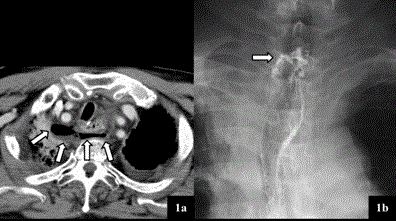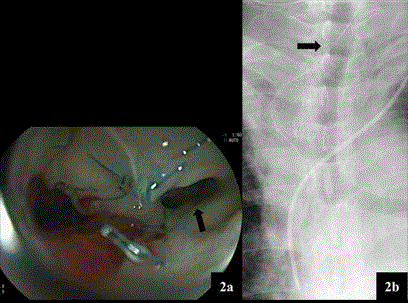Clinical Image
Endoscopic Transesophageal Drainage of Mediastinal Abscess caused by Anastomotic Leakage after Esophagectomy
Fumihiko Kato and Kazuo Koyanagi*
Department of Esophageal Surgery, National Cancer Center Hospital, Tokyo, Japan
*Corresponding author: Kazuo Koyanagi, Department of Esophageal Surgery, National Cancer Center Hospital, Tsukiji 5-1-1, Chuo-ku, Tokyo, 104-0045, Japan
Published: 20 Dec, 2017
Cite this article as: Kato F, Koyanagi K. Endoscopic
Transesophageal Drainage of
Mediastinal Abscess caused
by Anastomotic Leakage after
Esophagectomy. Clin Surg. 2017; 2:
1835.
Clinical Image
A 71-year-old male underwent salvage esophagectomy for residual cervical esophageal cancer after definitive chemo radiotherapy and reconstruction using gastric tube through the posterior mediastinal route. On Post Operative Day (POD) 8, Computed Tomography (CT) showed mediastinal abscess and swallowing contrast study demonstrated anastomotic leakage (Figure 1). Interventional CT-guided drainage was difficult because of the deep location of the abscess cavity; therefore, Tran’s esophageal drainage was tried. A guide wire was inserted into the abscess cavity through the leakage point assisted with transnasal endoscopy, and then, a12-Fr drainage catheter was inserted over the guide wire (Figure 2). The catheter was gradually decannulated according to weekly radiological assessment. He started taking solid food on POD 110, and the catheter was finally removed on POD 148. Anastomotic leakage and subsequent mediastinal abscess after esophagectomy are serious complications associated with high morbidity and mortality [1]. This case indicates that Tran’s esophageal drainage of the mediastinal abscess assisted with endoscopy is a less-invasive, safe, and effective treatment that helps in avoiding surgical reintervention.
Figure 1
Figure 1
Computed tomography showed mediastinal abscess (arrow). b: Swallowing contrast study
demonstrated anastomotic leakage (arrow).
Figure 2
Figure 2
Upper endoscopy showed a fistula on the right wall of the suture line (arrow). b: The trans esophageal
drainage catheter was inserted into the mediastinal abscess through the fistula (arrow), assisted by endoscopy.


